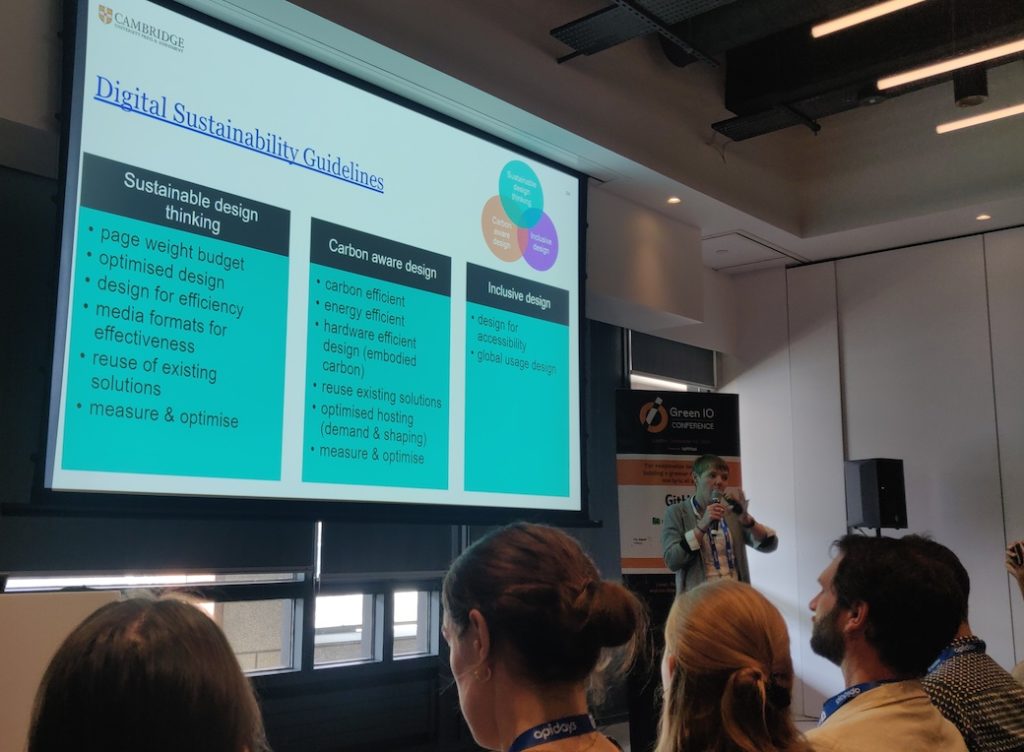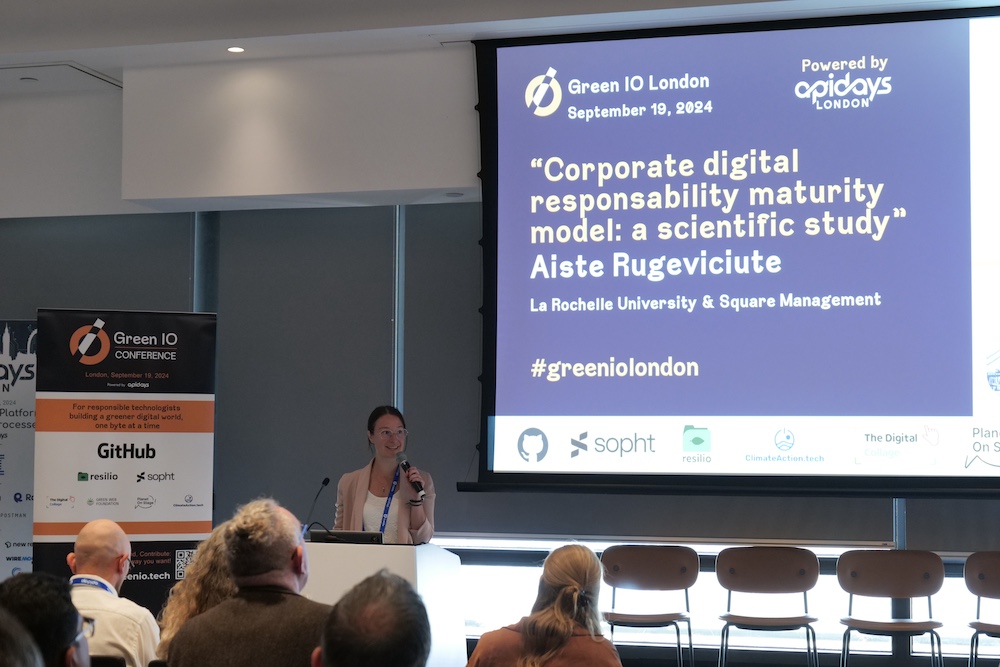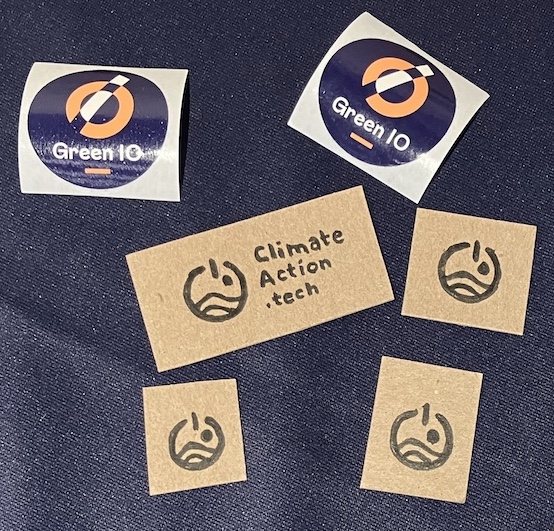Last week, volunteers and members of ClimateAction.tech (CAT) joined Green IO to bring sustainability awareness to the recent apidays conference in London. We learned about digital sustainability with special deep dives on AI, and we had a great time inspiring tech workers to take climate action at work.
Note: This is a re-post of an article co-written with Climate Action Tech volunteers, ClimateAction.tech joins Green IO London at the apidays conference.
Last week, volunteers and members of ClimateAction.tech (CAT) joined Green IO to bring sustainability awareness to the recent apidays conference in London. We learned about digital sustainability with special deep dives on AI, and we had a great time inspiring tech workers to take climate action at work.
The apidays conference brings together stakeholders in IT and tech seeking to learn about the latest trends and developments in the API industry. This year, the Green IO podcast (hosted by CAT member Gaël Duez) partnered with apidays to bring a focus on sustainability – offering talks and sharing knowledge and tools at the dedicated booths, all under the banner of Green IO London.
Members of the CAT community spoke about climate & tech on stage, promoted the community at our shared booth, and got the chance to meet each other in person.
Take-aways from the sustainability talks
The Green IO room was packed all day long, demonstrating a rise in interest for climate action. Here are a few of our learnings.
Use consensus, iterate in the open, and connect
In his keynote, CAT organiser Chris Adams started off the day with an overview of digital emissions.
![Audience in the foreground, Chris Adams on stage behind the lectern. The current slide reads “How do digital services cause emissions?”]](/images/blog/climateaction-tech-joins-green-io-london-at-the-apidays-conference/Green-IO-London-2024-Chris-Adams-Green-Web-Foundation-on-stage-keynote-1024x583.jpg)
Chris on stage going through fundamentals of digital service emissions [Credit: Thibaud Colas]
He then dove into the history of consensus as a decision-making approach in the tech industry and highlighted upcoming changes in carbon reporting laws. He summarised his talk by saying:
- If we want digital sustainability to spread like the internet, then rough consensus and iterating in the open (a thing we pride ourselves on in our community) is one of our climate levers.
- If we want to take advantage of the existing changes in the law in the context of our work, tech works can lobby internally for the inclusion of digital services in carbon accounting and reporting.
- Lastly, if our work is complementary, we will have more sway. Find ways to connect, not collect.
Chris’ work at the Green Web Foundation exemplifies all of these points. Check out carbontxt.org to learn more about digital sustainability and best practices.
Web sustainability guidelines are on course to become an official W3C standard
CAT member Alexander Dawson presented the Web Sustainability Guidelines on behalf of the Susty Web Community Group. This document is on course to become an official W3C standard, similar to the Web Content Accessibility Guidelines (WCAG). As Alexander says it’s “a hefty document”, but there’s been a lot of efforts made to make its contents more accessible.

Alexander Dawson introducing himself on stage [Credit: Thibaud Colas]
Later in the day, Andri Johnston and Julie Dennis brought a case study from Cambridge University Press & Assessment that put some of this theory into practice. They shared how they measured their digital carbon footprint and then took product action from their findings in this article: Digital sustainability: calculating our digital carbon footprint with actionable results.

Andri Johnston on stage [Credit: Elisa Escapa]
When designing, think beyond what’s best for the user and beyond
Thorsten Jonas, founder of the Sustainable UX (SUX) network, reminded us to consider the impact and cost of our product choices beyond our target audience. When we solely optimise for the end user, this always comes at the cost of other actors in the system. Taking those hidden costs into account helps us make better, more sustainable choices.
“A little bit less of everything first. Often before optimizing we should ask ourselves, if we really need the data, content or service at all“
– Thorsten Jonas
Include sustainability in your measures for success
Aiste Rugeviciute, of La Rochelle University and Square Management, presented her scientific study on a corporate digital responsibility maturity model (CDR MM), a systemic approach corporations can follow to adopt responsible digitalisation and organisational resiliency against climate change.

Aiste Rugeviciute on stage [Credit: Oliver Cronk]
Later on, CAT member and mini grant receiver Mark Butcher echoed Aiste’s advice to set company KPIs based on carbon emissions, not just cost or user-related KPIs. Mark also reminded us to challenge sustainability claims because “what cloud providers say, isn’t what they do”.
We need to talk about sustainability when we talk about AI
Multiple talks touched on the topic of AI and sustainability: CAT member James Martin highlighted the environmental impacts of AI with regards to water usage, embodied carbon of hardware, and the vast amount of electricity required to train models and generate output text, images, and videos.
One thought was shared by multiple speakers: The first question to always ask oneself is whether AI (and especially generative AI) is the right tool for the job. If it is, then tech workers can push data centre providers to share their operational data openly (How long are servers used for? How much water is used? How clean is the electricity used to run the workloads?) and to reduce their impact.
Later in the day, CAT organiser Sandra Pallier joined a roundtable with other climate NGOs represented by fellow CAT members Chris Adams (Green Web Foundation) and Maxim Fazilleau (The Digital Collage), as well as Anne Currie (Green Software Foundation), discussing the difference between using AI for sustainability purposes v.s. making AI sustainable.

Gaël starting off with the first question for the panel: Sandra, Maxime, Chris, Anne [Credit: Thibaud Colas]
Sandra emphasised the importance of knowledge sharing as we collectively navigate this new technology, and invited participants to join the CAT community; highlighting its aim to support members in learning, sharing, and working in the open, so that we can all take action for sustainability in the AI space.
All in all, a very insightful discussion thanks to all panel members. As a follow-up, we recommend reading the latest Green Web Foundation report (Thinking about using AI? Here’s what you can and (probably) can’t change about its environmental impact) and getting involved in conversations in our Slack community – #greener-data-ai channel.
For interviews and snippets from the talks – check out CAT member Oliver Cronk’s YouTube video.
Highlights from the booth & hallway
Apidays is a big conference. We all loved to see how receptive the audience is to sustainability considerations in our industry, and eagerness to learn more and engage with climate action in the future. This was visible not just through the audience numbers in the talks, but also through the folks visiting the booth and the conversations we had with attendees.
CAT had a shared booth with Green IO, Digital Collage, and Planet on Stage. Our organisations represent different opportunities for people to get started with climate action at work. All in a very accessible format, catering to people’s different needs (online material, in-person workshops, community chats).

CAT and other Green IO volunteers at the booth [Credit: Chris Pointon]
At the booth, we spent the day introducing attendees to climate tech communities and resources, and quizzing them on digital sustainability. We challenged their existing knowledge on the impact of digital on carbon emissions compared to the aviation industry, the number of hardware devices that exist in the world, and the vast amounts of data being created in the UK. We were chuffed to see how receptive participants were to the new information, sharing in their shock and intrigue the extent to which our digital lives have scaled at the cost of the environment.
It was also great to chat with members of other organisations who share a similar mission, such as Resilio, Sopht, and GitHub. But we took particular delight in getting to meet so many fellow CATs in person! It can be disheartening and isolating at times to work on climate action and push for change in our companies, and moments like these show us the profound impact our work can have on the industry at large.
Sometimes it’s the small things that have the biggest impact, like those lovely ClimateAction.tech badges hand-drawn by Sandra!

Climate Action Tech badges made of cardboard [Credit: Thibaud Colas]
Many thanks to our volunteers from the CAT community: Chris Pointon, Elisa Escapa, Fiona Leibundgut, Maxime Fazilleau, Oliver Cronk, Sam Partington, Thibaud Colas, and more! Let us know if you were there by sharing your insights and photos in #local-uk. 💚 Not a member yet? 👉️ Join the CAT community to learn about similar events in the future.
Want to join the next event in London? Our next Code Green London x CAT meetup is coming up in October.
And if you’re interested in helping organise CAT meetups in your region, reach out to one of the organisers and become an official CAT volunteer.